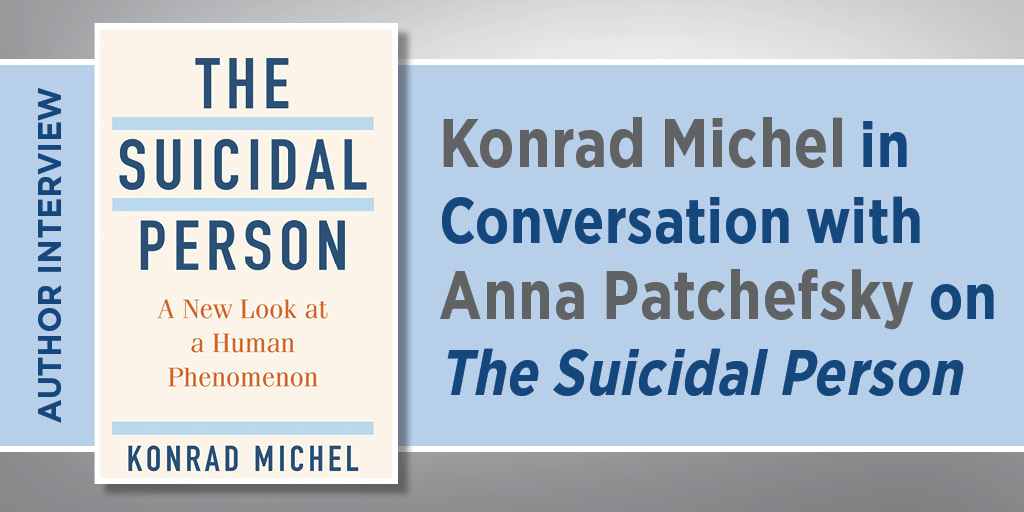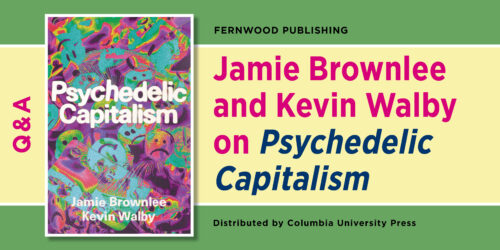Konrad Michel in Conversation with Anna Patchefsky on The Suicidal Person

Suicide is a difficult topic to discuss, both for suicidal individuals and for people who have been otherwise affected by suicide. Medical professionals often struggle to properly address the topic with patients. In The Suicidal Person, clinical psychiatrist and psychotherapist Konrad Michel provides insight into suicide, centering the stories of suicidal people and emphasizing the importance of connecting with suicidal patients as individuals. In this interview with Anna Patchefsky, Michel talks through new ways of conceptualizing suicide, effective treatments, and his own grief as a person affected by suicide.
Anna Patchefsky: Can you explain why, in your model of suicide, the personal story behind a suicidal crisis is such a central issue?
Konrad Michel: I have to take you back to the 1990s. My colleague, Ladislav Valach, PhD, who had published about action theory—or, more precisely, about the theory of goal-directed actions—challenged me, a medically trained mainstream psychiatrist, by pointing out that suicide is not an illness or a symptom of an illness, but an action, and that medically trained professionals (like me!) did not understand why people act in this or that way. The crucial point in action theory is that in everyday life we explain and understand actions, such as visiting a friend, using stories. So, when we evaluated patients who had survived a suicide attempt, we began asking them to tell us the story behind their suicidal crisis.
As a psychiatrist, I was used to bombarding patients with a set of questions about signs and symptoms of mental disorders. Now I had to learn that the roles were reversed: the patients were the experts of their story, and I was in the not-knowing position. And it worked! Most patients gave me a coherent story of how they came to the point of harming themselves, what triggered the suicide attempt, and how it related to their life story. This method, called narrative interviewing, is the opposite of a one-size-fits-all approach. The therapist acts as a coauthor of the patient’s story.
Patchefsky: How does the suicide-as-action model differ from other approaches?
Michel: The crucial difference compared to the medical approach is that, in our therapy, the patients are active participants throughout the therapy sessions, whereas in the traditional medical model patients are typically in a passive role, with the medical expert deciding what they need.
Patchefsky: In your book, you use the Tower of Babel as a metaphor—can you tell us more about that?
Michel: Medical professionals have learned that it is their responsibility to ensure the safety of their patients. They use all kinds of suicide risk scales to assess patient safety. But suicide risk assessments in the frame of the medical model don’t work because they miss the person inside the patient. I use the Tower of Babel metaphor to highlight the fact that doctors and patients speak different “suicide languages.” The typical medical professional understands suicide as a consequence of mental disorders, while the patient has personal and psychological dynamics that got them to the point of considering suicide as a solution to an unbearable mental state. Because the patient feels that the medical professional will not understand their inner turmoil, their pain and shame, they will not talk. I once heard somebody call the typical medical consultation with a suicidal patient “dancing without touching.” The way to improve communication is to reduce the gap between the medical professionals’ illness-based model and the patients’ own inner psychological experience.
I ran seminars for primary health physicians with the title “Don’t be afraid of suicidal patients,” and I found that the participants were extremely motivated to learn a new, patient-oriented approach. Mental health issues like depression are risk factors for suicide, and they need adequate treatment. But they are risk factors, not the cause of suicide.
Patchefsky: Can you explain your conclusions about suicide reporting?
Michel: Suicide reporting in the media is an important component of suicide prevention. Our study published in 2000, “An exercise in improving suicide reporting in print media,” is still today one of a few studies that shows that providing guidelines for media coverage of suicide can improve the quality of suicide-related articles, above all by making them less sensational and by avoiding the description of specific suicide methods. The crucial point in our study was that we had an extensive personal meeting with the editor in chief of the main tabloid in Switzerland, which also happened to be the main culprit of sensational suicide reporting. Since then, both national and international guidelines for suicide reporting have been published, and I believe that, generally, media professionals are now much more aware of the risk of sensational articles. But personal contact continues to be important. Still today I get queries from journalists and TV producers asking for my opinion.
Patchefsky: What is the “Werther Effect,” and can you explain its connection to the Netflix show 13 Reasons Why?
Michel: The Werther effect means the increase of suicidal behavior (suicidal thoughts, suicide attempts, and death by suicide) related to characters in widely published stories, reports, and movies people can identify with. The effect can be observed within days and can last over weeks and months. This is what happened with the television show 13 Reasons Why, with nearly 200 additional suicide deaths among ten- to seventeen-year-olds in the nine months following the series’s release.
But the Werther effect isn’t the only mechanism that shapes suicidal behavior. Another one is social learning. Throughout our lives, we can’t avoid hearing about suicide and suicide methods, and this knowledge may pop up again in times of crisis. The increase of suicide rates among adolescent girls (not only in the United States) is a long-term phenomenon that probably has various causes. I have no doubt that one of the factors is social media and the risk of experiencing rejection and cyberbullying , which can be detrimental for the young with a fragile sense of identity.
Patchefsky: About halfway through your book, you write, “We cannot escape the conclusion that the medical model has long ago reached its limits in reducing suicide.” Can you expand on that?
Michel: The fact is that, in spite of widespread suicide prevention projects, worldwide the suicide rates have not diminished significantly. There are national differences, with some countries reporting reduced suicide rates, while in other countries the suicide rate is increasing. So far, even comprehensive national prevention campaigns have not been able to show an effect on suicide rates. In most campaigns, the main focus is based on the medical model, which claims that suicide can be reduced with better recognition and treatment of psychiatric disorders, above all depression. We clearly need new models of suicidal behavior.
Patchefsky: What can you tell us about the Attempted Suicide Short Intervention Program (ASSIP)? How is it different from other methods?
Michel: In an early study, we found that suicidal patients rated the therapeutic relationship in narrative interviews significantly higher than in the usual clinical interviews. My colleague then suggested that we could enhance the therapeutic effect by video-recording the narrative interview and, in the next session, collaboratively watching the video. This technique is called video playback or self-confrontation. We then asked ourselves how our experience with these tools could be translated into a brief therapy program clinicians could use. Because all over the world there is a lack of resources for psychotherapy, I felt as we were developing ASSIP that it was important to keep the therapy program as brief as possible. We added a few more elements and limited the therapy to three (or four) sessions. The cognitive-behavioral therapies for people who attempted suicide are all much longer. The amazing thing—even for me—is that the results of our effectiveness study with 120 patients (60 ASSIP-treated patients and 60 control patients) revealed that ASSIP-treated patients experienced an 80% risk reduction for suicide reattempts over two years. In other words, the suicide-as-action model can give us very powerful tools for therapy with suicidal patients.
Patchefsky: What do you see as the next frontier in suicide prevention? What happens next?
Michel: I don’t know what, if anything, could happen next, but I have some ideas. Suicide research during the past thirty years has provided us with interesting insights into the brain, from genes to epigenetics to neurotransmitters and much more—but the cause of suicide has not been found, let alone the cure. Yes, there are some interesting substances, for instance ketamine, that can reduce suicidal ideation. But it is clear that suicide is more than an effect of faulty machinery of the brain; above all, it is a deeply personal and human phenomenon. I would be happy if the suicide-as-action model could induce some changes in the way that both health professionals and the general population understand suicide and the suicidal individual.
Patchefsky: There’s a section near the end of the book where you talk about losing your son, Alex, to suicide. When you describe your gradual grieving process, you say it felt like the thin ice you were walking on finally started to get thicker. Do you have any insights or advice that you might offer people who have lost someone to suicide—to those who carry on five years, ten years, or more after losing a loved one?
Michel: Death by suicide is the ultimate family catastrophe because we all feel that “it should not happen.” We all tend to feel responsible for the suicide of a loved one, and there are hundreds of questions to which we usually find no answers. Grieving is extremely individual. Here I can only talk about my personal experience. As a father I used to say that if one of my children should die I couldn’t go on with life. And then it happened. We, the parents, were supported by caring friends, which helped a lot. Like others, we tried to find explanations, but our son’s inner experience remained a mystery. The ice metaphor still holds for me after twenty-three years. In the first year after Alex’s death, it felt like walking on thin ice, with the threatening world of black, terrible, and unbearable pain very near below. Something that could devour me if the ice broke. But I learned that with time the ice got thicker and thicker, and that life does go on. I know that our son did not want us to suffer for the rest of our lives. People who consult me after the loss of a loved person by suicide usually find the concept of the suicidal mode—in which emotions take over, abolishing rational thinking, even thinking of the family—very helpful.
Patchefsky: Is there anything else that you would like to add?
Michel: Yes. Read the book!






